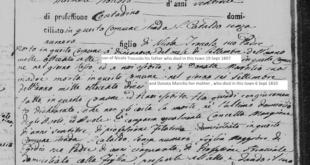Talking about one’s emotions is complex, both in one’s native language and certainly in an adopted language. In Italian, many phrases used to convey emotion are idiomatic, and the choice of verbs can differ with even minor differences in a situation.
For instance, an upcoming event may make one happy and generate positive feelings of excitement and anticipation. Although it is nice to have something to look forward to (as we discussed in Part 1 of this series about emotions last year), given the repetitiveness of daily life, we all feel bored at one time or another. It is a part of being human to feel negative emotions, and we commonly talk with family and friends about our feelings of boredom and annoyance.
Talking About Boredom in Italian — Annoiare and Annoiarsi
If something or someone is making a person bored, the Italian verb that describes the action “to bore someone“ is annoiare.
The present tense conjugation of annoiare is irregular in the tu and noi forms, similar to other –iare verbs where the “i” in the stem is omitted to avoid creating a stressed “i” sound with a double “ii.”
| Annoiare Present Tense | |
|---|---|
| io | annoio |
| tu | annoi |
| Lei, lei, lui | annoia |
| noi | annoiamo, |
| voi | annoiate |
| loro | annoiono |
Notice that annoiare is a “false friend” of the English verb annoyed!
Although annoiare sounds like the English verb annoyed,
these two verbs do not have the same meaning!
The past participle of annoiare is annoiato.
The reflexive verb, annoiarsi, means “to be bored” or “to get bored.” (Remember that reflexive verbs are used to convey the idea of “to get,” from our blog, “How to Say ‘Get’ in Italian.”)
The adjective that means boring is noioso(a).
The noun that means the bore or the boredom is la noia.
Now that we have listed the different parts of speech used to express the feeling of boredom in Italian, a word of caution:
But be careful!
To say something is “making you bored” in Italian,
you must tap into the Italian way of thinking!”
Of course, one could conjugate annoiare in the third person singular to describe how “it” or “someone” makes an individual feel bored. Remember to put the direct object pronoun lo or la (for him/her) before the verb, as usual with Italian sentence construction.
Questo film lo/la annoia. (from annoiare)
This film bores him/her.
But more commonly, Italians use dare — the verb that means to give — with the noun noia, for [dare + noia]. The effect is that “it” or “someone” is “giving boredom to” another!
In effect, although in English something or someone can “make” another bored,
in Italian things and other people “give” boredom with dare.
This brings up another grammatical point. Since boredom is being given to someone, indefinite object pronouns must be used to describe that someone. For the singular forms, you will recall the indirect object pronouns are “to me,” “to you,” “to him,” “to her,” in English, and mi, ti, gli, and le in Italian.
If you have been put into a boring situation
and want to describe your feeling of boredom,
once again, be careful!
If you are bored, i.e. have become bored and are feeling bored at certain point, use the past participle annoiato(a). In this case, the verb that means bored is used as an adjective following essere.
Do not follow essere with the adjective noioso(a) when referring to yourself, unless you want to say that you are boring!
To “get bored” use the reflexive form of annoiare, which is annoiarsi. (Again, remember that Italians express “to get” with reflexive verbs and see “How to Say ‘Get’ in Italian” for a refresher if you need to.)
Examples below show how annoiarsi, annoiare, [dare + noia], annoiato, and annoioso(a) are used to describe the different states of boredom. The Italian subject pronouns have been put in parentheses, as they are usually left out of the sentence in conversational Italian (as mentioned before in many previous blogs).
For our example conversation, let’s say we want to talk about the fact that someone is bored by a certain film.
The simple statement given as our first example above is repeated here. But as mentioned previously, this is not usually the sentence structure people use to communicate the feeling of boredom in Italian, so in the following examples, we continue on with other, more common ways to express boredom:
When I become bored…
Questo film mi annoia. (from annoiare)
This film bores me.
(Io) Mi annoio. (from annoiarsi)
I am getting bored.
Questo film mi da noia. / Mi da noia questo film. (from [dare + noia])
This film is making me bored. / (literally: This film is giving me boredom.)
(Io) Sono annoiato(a). (Use the past participle of annoiare here!)
I am bored.
If he or she becomes bored…
Questo film lo/la annoia. (from annoiare)
This film bores him/her.
Lui si annoia. / Lei si annoia. (from annoiarsi)
He is getting bored. / She is getting bored.
Questo film gli/le da noia. / Gli/Le da noia questo film. (from [dare + noia])
This film is making him/her bored. (lit. This film is giving him or her boredom.)
Ora, lui è annoiato. / Ora, lei è annoiata.
Now, he is bored. / Now, she is bored. (Use the past participle of annoiare here!)
And in this case, someone is bored about something (a certain film)…
Il film è noioso. (Use the adjective here!)
The film is boring.
But in another situation, a person, rather than a thing may be boring… Use the adjective noioso(a) in this case to describe the person!
Non sopporto Maria. Lei è cosi noiosa quando parla continuamente di suo marito!
I can’t stand Maria. She is so boring when she constantly talks about her husband!
Some ways to express just how exasperated you are by something or someone who is boring:
Che noia!
How boring!
Che palle!
How boring! (idiomatic expression)
Expressing Annoyance in Italian — Infastidire and Seccare
Of course, much as we love them, family members and friends can sometimes annoy us. The Italian verb infastidire means to annoy or to bother someone and is often used in reference to a child with the meaning “to pester.” The past participle, which can be used as an adjective, is infastidito(a).
The adjective that means “annoying, bothersome” or “pesky” is fastidioso(a).
Additional meanings for fastidioso(a) are “fussy, finicky,” and “fastidious.”
The noun that means the annoyance is ilfastidio. Fastidio is used with dare to create the phrase [dare + fastidio] to describe someone “giving annoyance” or “pestering” someone else. This is the same sentence construction used in the last section with noia!
As with annoiare, infastidire has a reflexive form, infastidirsi, which means “to get annoyed.”
The present tense conjugation for infastidire, which is a regular -ire verb that uses the “isc” in the ending, is given below. Examples follow.
| Infastidire Present Tense | |
|---|---|
| io | infastidisco |
| tu | infastidisci |
| Lei, lei, lui | infastidisce |
| noi | infastidiamo |
| voi | infastidite |
| loro | infastidiscono |
Mi infastidisco. (from infastidirsi)
I am getting annoyed.
Michele mi da fastidio! (from [dare + infastidire])
Michael is pestering me! (lit. he is giving annoyance to me.)
Sono infastidito(a). (Use the past participle of infastidire here!)
I am annoyed.
and in this case…
Michele è fastidioso. (Use the adjective to describe a person who is the pest!)
Michael is pesky.
Finally, seccare is another Italian verb that means to annoy, bother, or disturb someone, to the point of exasperation. Seccare does double duty as the verb that also means “to dry out.” It’s reflexive form, seccarsi, means both “to become annoyed” and “to dry out.” Seccare is a regular -are verb.
The adjective is seccante and the noun is la seccatura.
Both seccatura and fastidio/ fastidioso are used to refer to an annoyance or nuisance and are used to say, “How annoying…”
Che seccatura, la mia macchina non funziona!
How annoying (What an annoyance/What a bother), my car won’t start!
Quanto/Come sei fastidioso! Tu non mi ascolti mai!
How annoying you are! You never listen to me!
Ora, mi sono reso conto di quanto fastidiosa è questa regola!
Now, I realize how annoying this rule is!
Remember how to use the Italian verbs
annoiare, infastidre, seccare
and the adjectives annoioso and fastidioso
and I guarantee you will use these verbs on certain days!
For “All the Italian you need to enjoy your trip to Italy,” click on the links below to purchase my Conversational Italian for Travelers books – and then listen to the audiobook “Just the Important Phrases” on your favorite streaming platform! -Kathryn Occhipinti


 Fra Noi Embrace Your Inner Italian
Fra Noi Embrace Your Inner Italian






